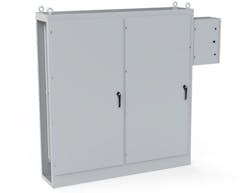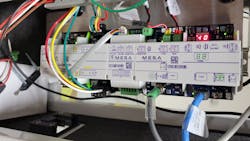Conventional wisdom is that there’s not much to selecting an industrial enclosure. Yet the last likely item chosen for an industrial control system turns out to have an outsized impact as a simple design miscue can send engineers back to the drawing board, slowing time-to-delivery as well as jeopardizing a system’s operational health.
Enclosures are the cabinetry that play an essential role in protecting machinery controls, circuit boards, cabling, switches, and other critical electronics and automation components from environmental elements like dust, water, and extreme temperatures. They are also the central housing backbone for the auxiliary components necessary for many industrial automation applications—for example, cooling systems such as heat exchangers and fans are now commonplace as the number of heat-generating electronics used in control applications has mushroomed over the years.
"Compared to everything else in the automation world, enclosures are the ‘dumbest’ product out there—they don’t plug in, they don’t have firmware, yet they serve an important purpose,” says Jody Kinney, product manager for AutomationDirect, a direct e-commerce distributor of industrial products. “The big part is understanding what your environment is so you can understand what you need. Many people think it’s simpler than it is.”
A modular approach
to boost flexibility
With its 40-year history serving a variety of
industries as an electrical contractor, including
panel building and system integration work,
Conaway Electrical Service Inc. has hardly
landed a contract or job that didn’t call for some
form of industrial enclosure.
“Whether we’re upgrading equipment for a customer
with existing enclosures or starting fresh
with a new design and specification, 90% of what
we do involves enclosures—everything from a low voltage
data network or camera installation up to
a high-voltage power distribution,” says Jeff Sheffield, superintendent with Conaway. “All of these
product offerings involve enclosures.”
Conaway serves a range of industries so enclosure flexibility is crucial given that the feature set and enclosure configuration will vary significantly depending on the nature of the control application. The need for versatility led Conaway to Rittal’s family of modular enclosures— a partnership that has spanned nearly 30 years and allowed the firm to service applications in food & beverage, chemical, automotive, battery, and myriad other industries.
As opposed to a traditional unibody enclosure, Rittal takes a modular approach to its product line, starting with a metal-formed frame that can accommodate accessories as well as be joined with other frames to create a nearly infinite number of configurations. This approach allows customers to create side-to-side, back-to-back, or side-to-back enclosure system designs. It also simplifies modifications if the end user’s needs shift without incurring costly fabrication techniques.
“There’s real flexibility in the design and ways to grow and configure a cabinet,” says Robbie Hall, system consultant at Rittal. It's also less complicated to replace parts, repair any mistakes made with cut outs, or correct paint damage—all tasks that are much harder to take care of with the classic unibody enclosure style, Hall maintains.
Rittal’s modular enclosure design has enabled Conaway to accommodate the needs of its clients, Sheffield says. For example, in one recent deployment, Sheffield’s team was able to optimize a client’s tight spacing restrictions by making a smaller panel on one side of the enclosure and a taller option on the other end. “As long as I think of my design as modular, it gives my customers extended flexibility,” he says.
In all his years working with industrial enclosures, the greatest challenges always come down to a case of inadequate planning or miscues on enclosure size due to underestimating the spacing requirements of individual components. “You need to have a good understanding of the components you’re putting into the enclosure and their requirements—that’s what is going to drive what kind and how big your enclosure needs to be,” he says, adding that it’s a hard lesson most integrators and control engineers learn over the years based on trial and err or.
EPlan, design software for machine and panel builders offered by Rittal, helps address those challenges, ensuring Conaway avoids such errors as part of its current enclosure design practices.
Another common mistake practitioners make when considering enclosures is putting too much focus on the lowest cost as opposed to total cost of ownership. “They’re not looking at what it costs to integrate or engineer the product, [meaning that] things aren’t well thought out across the board,” Rittal’s Hall says. “Enclosures aren’t looked at as a technology piece—it’s more about the stuff inside like drives and PLCs. Not enough time is spent thinking about the technology involved in the actual cabinet and what it is housing.”
A less flashy, but still central element in its offering are industrial enclosures from Phoenix Contact. These enclosures are essential to protecting the lifeblood of Mesa Technologies’ intelligent traffic systems from environmental factors. The enclosures also create an accessible deployment environment that allows city technicians, who don’t have machine building and industrial automation experience, to easily configure and maintain traffic systems once they are out in the field.
Rather than developing a traditional schematic provided with an enclosure, Mesa worked with Phoenix Contact to custom print a layout directly on the enclosure so technicians know exactly where every termination needs to go as part of an overall assembly roadmap. “When a customer goes to install or manufacture, everyone knows exactly where every component is going,” explains Todd Jackson, product officer at Mesa. “The drawing shows what the connector looks like so it’s easy to install.”
Because Mesa is committed to designing as much componentry as possible in-house, enclosure flexibility was critical. For example, Mesa was building its own power supply board for one product, which needed to snap on to a DIN rail. Phoenix was able to deliver an enclosure that accommodates the board while still allowing it to be affixed to a DIN rail, ensuring protection from environmental factors.
“Each board has a different function in a traffic system, and we can offer different size enclosures to accommodate different size printed circuit boards,” says Travis Prause, senior electronics sales engineer at Phoenix Contact.
To avoid unwanted, last-minute surprises, Prause says customers should retool processes and work with enclosure providers to consider the enclosure as part of early-stage PCB (printed circuit board) design. “If they design the PCB first and look for enclosure to fit the board after, it seldom works,” he says. “If we’re talking to customers early on in the product design cycle, it’s easy to f ind the right enclosure.”
“Customers will consider an environmental rating that gives specific requirements, but that standard only looks at a portion of what that environment is,” notes Ron Zeitler, quality assurance manager for Saginaw Control & Engineering. “You have to consider all of the environmental issues in the end-use environment, not just the type of rating .”
As part of the selection process, it’s important to fully understand where the enclosure will be used to address factors such as physical security, mounting requirements, and accessibility. Thermal management is another critical aspect of enclosures as integrators will often need to include different forms of cooling devices—many of which may not be compatible with specific environments where water or extreme cold temperatures are involved, Kinney says. Another important consideration is size—too many control engineers don’t pay close attention early on to the size and spacing needs of components like HMI screens or fans and then end up saddled with an enclosure that doesn’t scale properly to accommodate the full bill of materials.
Kinney advises customers to keep longevity in mind when selecting an enclosure, at least beyond the service life of the internal components, to avoid having to purchase a new enclosure and endure the hassle of remounting and optimizing components.
“Put the work in on the front end so you don’t have to think about it on the back end,” Kinney says. “Once the enclosure is installed, the only thing you should worry about is troubleshooting and maintaining the equipment inside. The enclosure should be able to do its job in perpetuity.”




